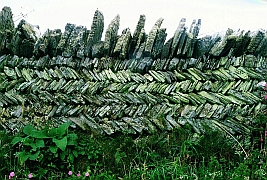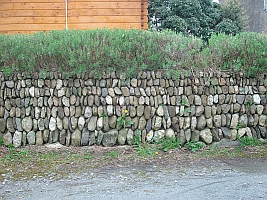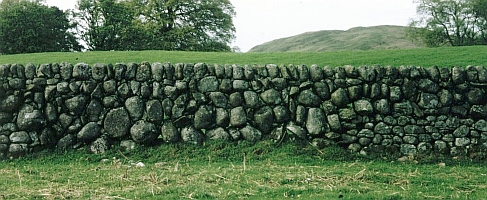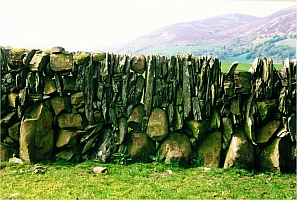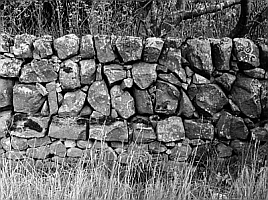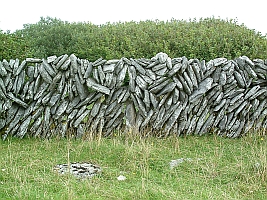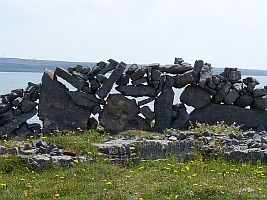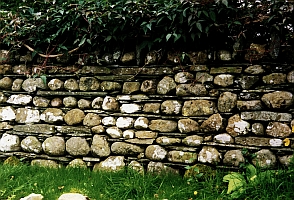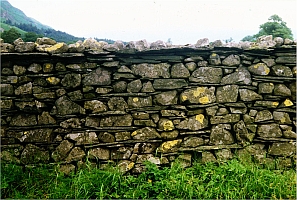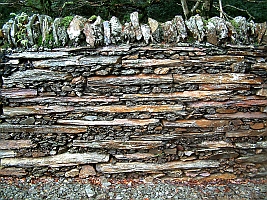Patterns
The following is based on an article in "Waller and Dyker" Spring 2011. It will be adapted to take into account an article to be published in late 2012, which refers to this page as it can be seen here. I shall add more photos when time permits!
This website has an associated presentation, developed for the Stone Foundation Symposium held in Ventura California 2010, and last aired in March 2011, to the Conwy Historical Society, (bookings currently being taken). The talk's title: "Inscriptions on the Landscape", is derived from a quote by Geoffrey Grigson1, discovered in my footpath maintenance days. When walling hi-jacked my life it occurred to me that it was far more appropriate description of our craft. One section of the talk, "Handwriting", covering wall patterns, has yet to make it online. Some patterns are highly localised and overlooked, given this variety, the omission needs remedying.
Walls tend to be categorised as random or coursed, with tens of thousands of miles of random wall you would expect to see variations, but with coursed walls you might be forgiven for assuming there is very little variation.
However there are some striking variations such as the herringbone walls of the slate areas of North Cornwall (notably around Tintagel, left) and Pembrokeshire. Welsh Cloddiau - stone faced earth banks with the stones 'bookended' (right), are the predominant boundary in parts of North West Wales, and can be found sporadically along much of Britain's west coast.
Perhaps
the most obvious regional pattern are the single boulder dykes of Scotland, incredible structures only one stone thick, and the related "Galloway Dykes" - doubled for their first lift and single thereafter. These too have their variations. The wall above in Murrayton (Dumfries & Galloway) shows a mixture of the two, known as 'butt and hudd'; (PLEASE NOTE THE FOLLOWING DEFINITION/TEXT IS INACCURATE AND DUE TO BE CORRECTED FOLLOWING PUBLICATION OF AN UPDATE IN "WALLER AND DYKER") . Here there are either too many small stones for a pure single, or too many boulders for a Galloway. The wall is then built in a series of panels. As with many local patterns this is an ingenious and efficient way of using up the available stone. As well as requiring a whole new technical approach.
There are many patterns of single and Galloway, usually determined by local stone. Again using this to its best advantage as on Bute (left) and South Lanarkshire (Right).
Singles can also be found scattered throughout England, particularly in Devon (there are some impressively large stones on the road near Princeton), and Wales. Generally these are flat laid rather than vertical.
Another striking variation are the lace walls of western Ireland. Often little more than stone balancing, they seem to defy gravity. Many local patterns use techniques far from what we would regard as normal. At an esoteric level they provide plenty of scope for point theory and friction arguments, or something like that. You'd have to ask Craig Arbennigol. If you look closely you can see bedrock poking through the grass.
Both walls (from County Clare on the left, and Inis Mor on the right)are set on bedrock, they can't settle so essentially the stone doesn't move and the gaps are more or less fixed.
An interesting variation on the Galloway theme is the "fragment fence" on Inis Mor (below left). This is a highly localised pattern, for which I am yet to find a satisfactory explanation. Locally the vertical stones in the doubling are known as mothers, the small building stone are the children, whilst the larger capping stones are the daddy's. Interestingly there is a variation on this theme found on the Isle of Man, where the larger vertical stones are found in the singling on top, rather than in the double.
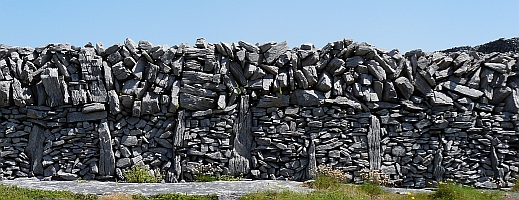
|
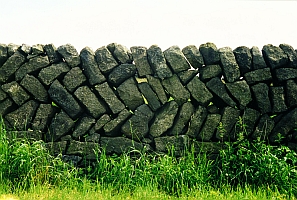
|
Another interesting 'Galloway' is shown right, from Stanton on the Staffordshire/Derbyshire border. Sometimes patterns are highly localised. There are just a few of these in one village (or there were 15 years ago, such localised patterns could easily disappear overnight). It's around halfway between Cornwall and Dumfries & Galloway, and in the absence of any other logical explanation I like to romanticise that a waller travelling south and another travelling north met here by accident and this was the result. Highly local stiles can always just be a builders whim. Having survived they are of no less interest than 'standard' patterns.
The walls of the Lake District are many and varied. In some areas slate is incorporated in the structure. There are some impressive walls of this type in Langdale. Elsewhere the wall left, almost coursed is in Grange, whilst Rosthwaite (right) has an interesting range of walls with different amounts of slate. Another talk uses these to try to illustrate that walls fit into the 6 degree of separation theory if you stay awake long enough. The point being that they are all subtly different and distinct. If you can actually see the stone for the wall that is, paraphrasing trees and wood.
The wall below left, from Penrhyndeudraeth in North Wales, actually parallels the Rosthwaite pattern in many ways, but with very different stone. The walls near this village and along part of the nearby Ffestiniog Railway are as far as I know unique.
Large slabs sandwiching very small stone. In many the smaller stones are throughs, in others little more than long hearting. A local use that breaks the rules, yet works. Walls out of small stone tend to have problems, as do walls built of long traced slabs. Do these work because the slabs bed well? Normally if slabs are incorporated in a wall many stones under the slabs work loose. Do the small stones settle and absorb any movement? All sorts of interesting possibilities. Lots of scope for esoteric thought and debate, not least how the original builders came up with the pattern in the first place.
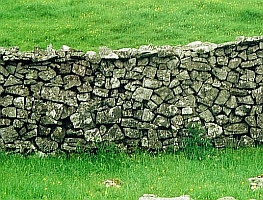
|
Polygonal walling is commonplace around the Mediterranean, in Britain it is particularly rare. One example is this wall (right) at Winskill farm near Settle. Identifying these walls is particularly difficult. To many, they look like poorly built walls with higgledy-piggledy stonework. However they are set apart by the tightness of the build and the lack of small pins. At times such distinctions are very subtle and often tenuous.
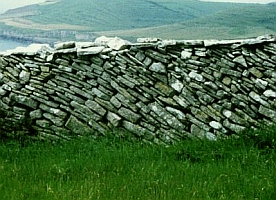
|
Moving far from the straight and narrow, many of the walls of Purbeck, Dorset are built with the stone set in angled layers rather than on the flat. Elsewhere in Pembrokeshire (right) and Devon there are numerous examples of the stone being set vertically and randomly (unlike coursed cloddiau).
Many harbour walls are built this way as vertical stone is less likely to be loosened by wave action. At Castlehill, Thurso, there is a key built out of enormous sandstone flags, search for Castlehill harbour on www.flickr.com there are a couple of shots of the quay and much more besides.
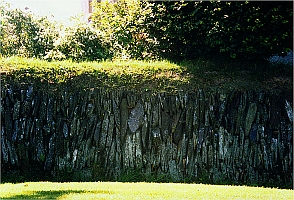
|
So having apparently come full circle, we've still only scratched the surface. One theme of "Inscriptions" is that we often take what is immediately around us for granted; even assuming that it is the norm when it is in fact rare, that is if we notice it exists at all.
Patterns of stonework can centre on a village, even a farm. They may cover a county, or the country. Many are repaired "correctly" rather than maintaining the vernacular, presumably people do not even realise they are different. Identifying them is a challenge. The variety deserves mention within Walling Treasures, and some local styles are highly endangered. If you are aware of something different in your area, maybe on just one farm, or even a large number of walls in your area as a whole, which differ from the `norm`, please let me know… sean@stonewaller.freeserve.co.uk
Reference
1 Geoffrey Grigson "Freedom of the Parish" London, 1954, p. 158 in Kim Taplin's "The English Path" (1st Editon 1979)
All photos copyright Sean Adcock
